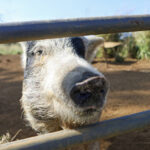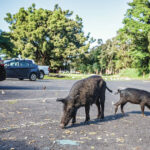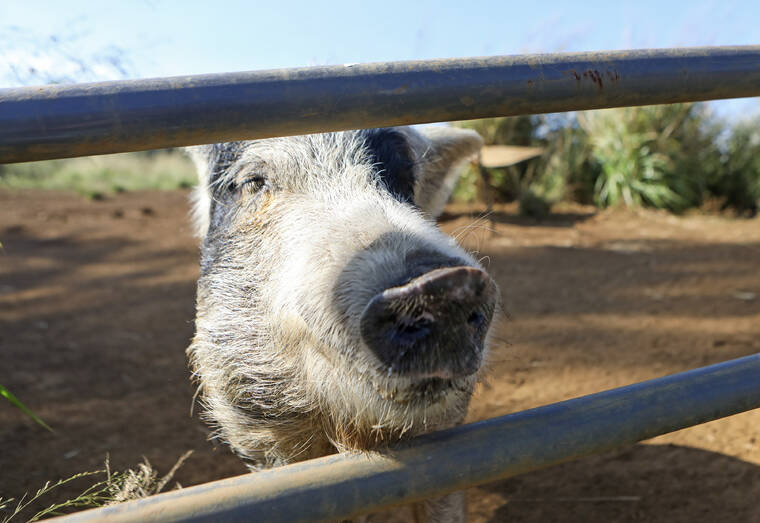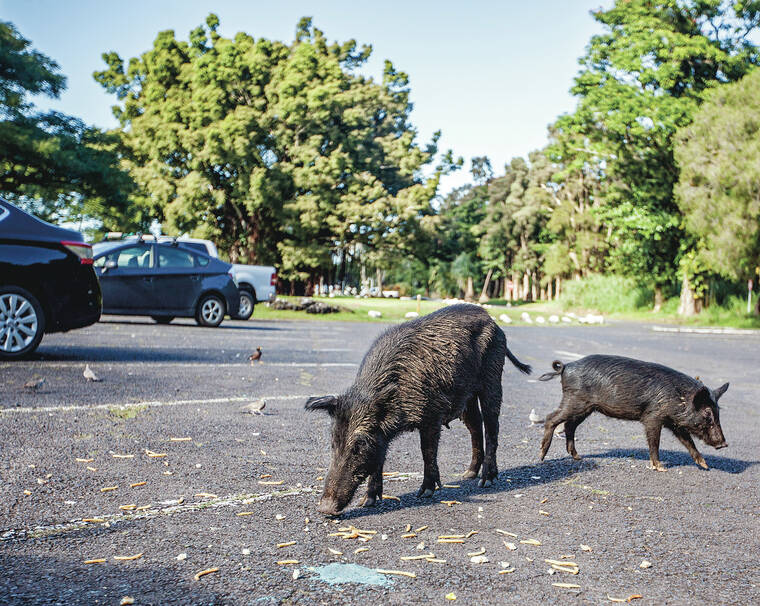East Hawaii farmers could be reimbursed for the cost of installing or replacing ungulate fences through a federal grant program.
The “Perimeter Fencing for Feral Swine Grant Program” is a national program administered through the Natural Resources Conservation Service. Of its $7.5 million budget, $400,000 has been allocated to cover the cost of fences for farmers bedeviled by feral pigs in the Hamakua, Waiakea and Puna Soil and Water Conservation Districts.
At a workshop in Hilo on Thursday, NRCS Planner Chloe Gallegos told farmers and other attendees that, as long as they live within the three eligible conservation districts, have farm records established with the Farm Service Agency, and can provide evidence of pig damage on their properties, they are eligible to apply for the program.
“We’ll take any evidence you have, except an actual pig,” Gallegos said.
If a farmer’s application is granted, conservation district staff will determine the length of fence needed and issue a total cost estimate. After a contract has been signed between the farmer and the chairperson of the conservation district board and the fence has been installed, a planner will certify that the fence has been built to specifications and a reimbursement check will be in the mail.
However, farmers won’t just be free and clear once the fence is installed. The fence first must be installed by October 2025, although Gallegos said that deadline is flexible. The farmer is also responsible for maintaining the fence for 20 years, which includes replacing broken parts and mowing grasses around it.
The farmer is also prohibited from removing trees taller than 15 feet to clear the fence line between June 1 and Sept. 15, in order to not disrupt the Hawaiian Hoary Bat pupping season.
Gallegos added that, with only $400,000 available for all farmers within three very large conservation districts, the program will be highly competitive.
Additional funding for the program might be available in the future, which could expand it to the entire island, Gallegos said.
Elsewhere during Thursday’s workshop, other county, state and private groups encouraged other methods to control feral pigs to prevent the spread of diseases such as brucellosis, which is not only dangerous to animals and humans, but has the potential to wreak devastation on the island’s economy.
Brucellosis, an infectious bacterial disease transmitted through bodily fluids, can cause abortion rates between 80% and 90% among pigs, and cannot be cured, said Kim Kozuma, field veterinarian for the U.S. Department of Agriculture.
“It’s gnarly,” Kozuma said. “You can lose your shirt from this.”
Kozuma said she knows of at least five horses on the island to have been infected with brucellosis, along with two humans. The disease often displays no symptoms, and it is generally considered safer to assume that all pigs on the island carry the disease.
Because the bacteria that causes brucellosis is spread by bodily fluids and killed by thorough cooking, Kozuma urged hunters to properly handle their kills.
Stephen Hess, station leader at the U.S. Department of Agriculture’s Hawaii Field Station, advocated for trapping as the most effective method for controlling pigs. A trial program between November 2021 and May 2022 found that net traps — specifically a brand called “Pig Brig,” which is a netted enclosure that can trap several pigs at once — are far and away the most successful method of capturing pigs.
Hess calculated that Pig Brigs can capture 1.36 pigs per hour of work. No other method, including snares and hunting, reached a rate even close to more than 1 pig per hour. One hunter at Thursday’s workshop said he was able to trap 35 pigs in a single day using a Pig Brig.
USDA wildlife specialist Jordan Linnell pointed out that hunting is inefficient because hunters will gravitate toward large kills, like boars, while leaving sows alive, allowing them to quickly outbreed any loss to the herd.
Glenn Sako, agriculture specialist with the county Research and Development Department, said between 70-80% of a pig herd needs to be caught to effectively reduce its population.
Although the Pig Brigs come highly recommended, they are often too expensive for individuals, selling online for $3,000 each. Sako said County Research and Development is partnering with nonprofit Malama O Puna to lend the traps to homeowners’ assocations.
Email Michael Brestovansky at mbrestovansky@hawaiitribune-herald.com.









